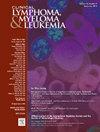DA-R-EPOCH May Mitigate the Adverse Prognostic Implication of the Diagnosis-to-Treatment Interval (DTI) in Large B-Cell Lymphomas
IF 2.7
4区 医学
Q2 HEMATOLOGY
引用次数: 0
Abstract
Background
Short diagnosis-to-treatment interval (DTI) is associated with high-risk disease and poor survival in diffuse large B-cell lymphoma (DLBCL). There is a paucity of literature on DTI and survival in DLBCL treated with first-line DA-R-EPOCH. We hypothesized that rapid initiation of DA-R-EPOCH in aggressive and high-risk DLBCL mitigates the adverse prognostic implication of short DTI.
Patients and Methods
We retrospectively examined the association of DTI, categorically (short DTI ≤ 14 and long > 14 days) and continuously, with clinical features and survival outcomes in DLBCL treated with first-line DA-R-EPOCH at our institution.
Results
A total 190 patients were analyzed, 21% with high-grade DLBCL subtypes, 56% IPI ≥ 3, and median DTI of 13 days. The short DTI cohort contained more patients with IPI ≥ 3, bulky disease, and elevated LDH. When analyzed categorically and continuously, DTI was not associated with significant differences in PFS or OS. There was significant multivariable interaction between bulky disease, DTI, and PFS (P = .033), with improved PFS in patients with bulky disease in the short DTI cohort.
Conclusion
We found that negative prognostic implications of DTI are mitigated in DLBCL patients treated with first-line DA-R-EPOCH, suggesting that urgent initiation of DA-R-EPOCH in high-risk DLBCL, including bulky disease, may improve survival. Our study's shorter DTI compared with DTIs reported in prospective DLBCL trials highlights DTI as a marker of external validity in clinical trial results. Future trials should implement protocols encouraging shorter, realistic DTIs to avoid selection bias against high-risk patients who are unable to delay treatment.
DA-R-EPOCH可减轻大B细胞淋巴瘤诊断到治疗间期(DTI)的不良预后影响
背景:弥漫大B细胞淋巴瘤(DLBCL)的诊断-治疗间隔(DTI)短与疾病风险高和生存率低有关。关于DLBCL一线DA-R-EPOCH治疗的DTI和生存率的文献很少。我们假设,在侵袭性和高危DLBCL中快速启动DA-R-EPOCH可减轻短DTI对预后的不利影响:我们回顾性地研究了本院接受一线DA-R-EPOCH治疗的DLBCL患者中,DTI的分类(短DTI≤14天和长DTI>14天)和连续性与临床特征和生存结果的关系:共分析了190例患者,其中21%为高级别DLBCL亚型,56% IPI≥3,中位DTI为13天。短DTI队列中IPI≥3、大块病变和LDH升高的患者较多。如果进行分类和连续分析,DTI 与 PFS 或 OS 的显著差异无关。大块疾病、DTI和PFS之间存在明显的多变量交互作用(P = .033),短DTI队列中大块疾病患者的PFS有所改善:结论:我们发现,在接受一线DA-R-EPOCH治疗的DLBCL患者中,DTI对预后的负面影响得到了缓解,这表明在包括大块疾病在内的高危DLBCL患者中紧急启动DA-R-EPOCH可能会改善患者的生存。与前瞻性 DLBCL 试验报告的 DTI 相比,我们的研究中的 DTI 较短,这突出表明 DTI 是临床试验结果外部有效性的标志。未来的试验应实施鼓励缩短DTI的方案,以避免对无法延迟治疗的高危患者产生选择偏倚。
本文章由计算机程序翻译,如有差异,请以英文原文为准。
求助全文
约1分钟内获得全文
求助全文
来源期刊

Clinical Lymphoma, Myeloma & Leukemia
ONCOLOGY-HEMATOLOGY
CiteScore
2.70
自引率
3.70%
发文量
1606
审稿时长
26 days
期刊介绍:
Clinical Lymphoma, Myeloma & Leukemia is a peer-reviewed monthly journal that publishes original articles describing various aspects of clinical and translational research of lymphoma, myeloma and leukemia. Clinical Lymphoma, Myeloma & Leukemia is devoted to articles on detection, diagnosis, prevention, and treatment of lymphoma, myeloma, leukemia and related disorders including macroglobulinemia, amyloidosis, and plasma-cell dyscrasias. The main emphasis is on recent scientific developments in all areas related to lymphoma, myeloma and leukemia. Specific areas of interest include clinical research and mechanistic approaches; drug sensitivity and resistance; gene and antisense therapy; pathology, markers, and prognostic indicators; chemoprevention strategies; multimodality therapy; and integration of various approaches.
 求助内容:
求助内容: 应助结果提醒方式:
应助结果提醒方式:


